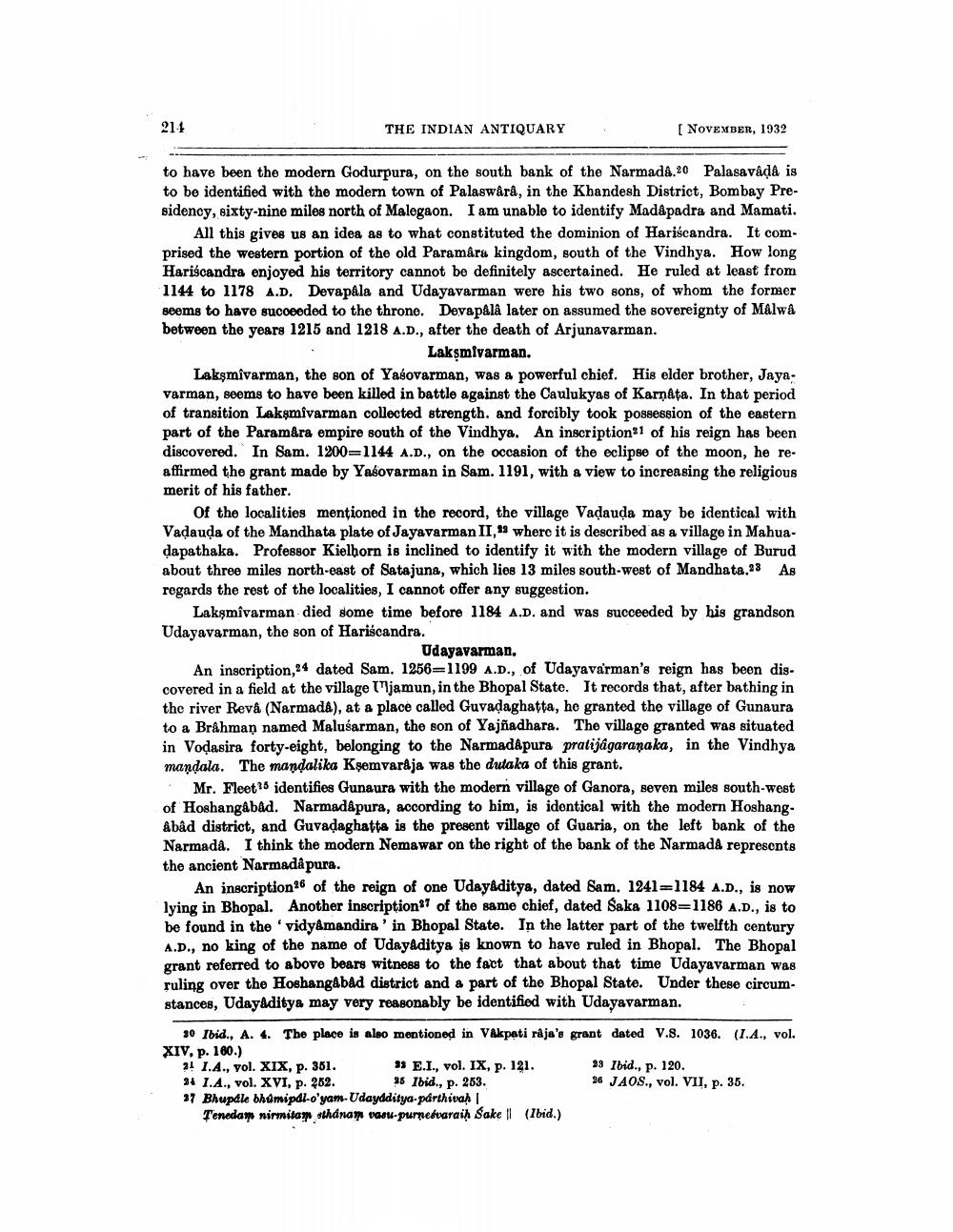________________
214
THE INDIAN ANTIQUARY
NOVEMBER, 1932
to have been the modern Godurpura, on the south bank of the Narmad&.20 Palasavāda is to be identified with the modern town of Palaswårå, in the Khandesh District, Bombay Presidency, sixty-nine miles north of Malegaon. I am unable to identify Madápadra and Mamati.
All this gives us an idea as to what constituted the dominion of Hariscandra. It comprised the western portion of the old Paramâra kingdom, south of the Vindhya. How long Hariscandra enjoyed his territory cannot be definitely ascertained. He ruled at least from 1144 to 1178 A.D. Devapala and Udayavarman were his two sons, of whom the former seems to have succeeded to the throne. Devapalâ later on assumed the sovereignty of Mâlwa between the years 1215 and 1218 A.D., after the death of Arjunavarman.
Lakşmivarman. Lakşmivarman, the son of Yasovarman, was a powerful chief. His elder brother, Jayavarman, seems to have been killed in battle against the Caulukyas of Karnata. In that period of transition Lakşmivarman collected strength, and forcibly took possession of the eastern part of the Paramara empire south of the Vindhya. An inscription of his reign has been discovered. In Sam. 1200=1144 A.D., on the occasion of the eclipse of the moon, he reaffirmed the grant made by Yasovarman in Sam. 1191, with a view to increasing the religious merit of his father.
Of the localities mentioned in the record, the village Vadauda may be identical with Vadauda of the Mandhata plate of Jayavarman II, where it is described as a village in Mahuadapathaka. Professor Kielhorn is inclined to identify it with the modern village of Burud about three miles north-east of Satajuna, which lies 13 miles south-west of Mandhata.23 As regards the rest of the localities, I cannot offer any suggestion.
Lakşmivarman died some time before 1184 A.D. and was succeeded by his grandson Udayavarman, the son of Hariscandra.
Udayavarman. An inscription,84 datod Sam. 1256=1199 A.D., of Udayavarman's reign has been dis. covered in a field at the village t'jamun, in the Bhopal State. It records that, after bathing in the river Revå (Narmada), at a place called Guvadaghatta, ho granted the village of Gunaura to a Brâhman named Malusarman, the son of Yajñadhara. The village granted was situated in Vodasira forty-eight, belonging to the Narmadapura pratijagaranaka, in the Vindhya mandala. The mandalika Ksemvaraja was the dutaka of this grant.
Mr. Fleet15 identifies Gunaura with the modern village of Ganora, seven miles south-west of Hoshangabad. Narmadapura, according to him, is identical with the modern HoshangAbâd district, and Guvadaghatta is the present village of Guaria, on the left bank of the Narmada. I think the modern Nemawar on the right of the bank of the Narmadå represents the ancient Narmadå pura.
An inscription26 of the reign of one Udayaditya, dated Sam. 1241=1184 A.D., is now lying in Bhopal. Another inscriptions of the same chief, dated Saka 1108-1186 A.D., is to be found in the 'vidy&mandira ' in Bhopal State. In the latter part of the twelfth century A.D., no king of the name of Udayaditya is known to have ruled in Bhopal. The Bhopal grant referred to above bears witness to the fact that about that time Udayavarman was ruling over the Hoshangabad district and a part of the Bhopal State. Under these circumstances, Udayaditys may very reasonably be identified with Udayavarman.
30 Ibid., A. 4. The place is also mentioned in VAkpati raja's grant dated V.8. 1036. (1.A., vol. XIV, p. 160.) 3! 1.A., vol. XIX, p. 361.
9 E.I., vol. IX, p. 121. 33 Ibid., p. 120. 24 1.A., vol. XVI, p. 252. 95 Ibid., p. 253.
26 JAOS., vol. VII, p. 35. 37 Bhupale bhumipdl-o'yam-Udaydditya-párthivah
Teneday nirmitam sthanam paru-purnedvaraih Sake || (Ibid.)




